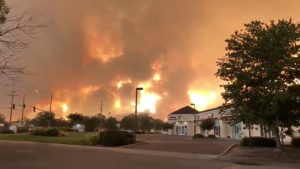
By Fred Greaves
REDDING, Calif (Reuters) – One person was killed in a rapidly moving wildfire that sent residents fleeing from a northern California city where homes and businesses burned and power was cut on Friday, fire officials said.
A bulldozer operator was killed in the so-called Carr Fire, a blaze in Shasta County that has tripled in size in the last two days to 28,000 acres (11,300 hectares), the state’s forestry and fire protection department (Cal Fire) said.
The blaze moved east from the communities of Whiskeytown and Shasta and crossed the Sacramento River and now threatens hundreds of homes on west side of the city of Redding. Cal Fire said it ignited on Monday by the mechanical failure of a vehicle.
“The fire is moving so fast that law enforcement is doing evacuations as fast as we can. There have been some injuries to civilians and firefighters,” California Department of Forestry and Fire Protection spokesman Scott McLean told the Sacramento Bee newspaper.
“It’s way too dynamic and burning quickly.”
Local and state fire officials were not available to confirm details of injuries or the extent of damage.
Roads out of the city of 90,000 people were jammed with motorists trying to escape the flames, social media postings showed.
Two residents who chose not to leave were 61-year-old Rob Wright and his wife, who planned to fight off flames from approaching their house with a high-powered water hose.
“We were fortunate enough that the wind changed about hours ago and it is pushing the fire back,” said Wright, at about 1:15 a.m. local time. “We are just waiting it out … crossing our fingers and hoping for the best.”

Smoke and flames are seen as a wildfire spreads through Redding, California, the U.S., July 26, 2018, in this still image taken from a video obtained from social media. @pbandjammers/via REUTERS
“TRYING TO MAKE A STAND”
Scorching temperatures above 100 degrees F (37 C), erratic winds and low humidity that are expected in the area could fan the blaze, which 1,700 firefighters are battling, Cal Fire and weather forecasters said.
“Right now they’re doing what they can, they’re trying to make a stand where they can, if possible,” McLean said. “It’s extreme. It’s blowing up off and on again.”
McLean added that the wildfire was in an area of rolling hills and not in “house-to-house neighborhoods.”
Video footage and images posted on social media showed flames engulfing structures as an orange glow lit up the night sky.
Residents were evacuated to a nearby college and elementary school and a local ABC news station stopped covering the fire in order to evacuate. The Mercy Medical Center in Redding evacuated its neonatal intensive care unit, it said in a statement.
Multiple power outages were reported, the city said on its website, adding that the electric utility was shutting off power in its northern areas.
California Governor Jerry Brown declared a state of emergency in Shasta and Riverside Counties on Thursday over the Carr and Cranston fires.
The California Governor’s Office of Emergency Services said it had activated a state operations center to provide assistance in multiple wildfires burning in Northern and Southern California.
Two weeks ago, a firefighter was killed fighting the Ferguson Fire east of San Francisco when a bulldozer he was using to cut containment lines overturned. Seven other firefighters have been hurt.
(Additional reporting by Brendan O’Brien in Milwaukee; Editing by Kevin Liffey)












